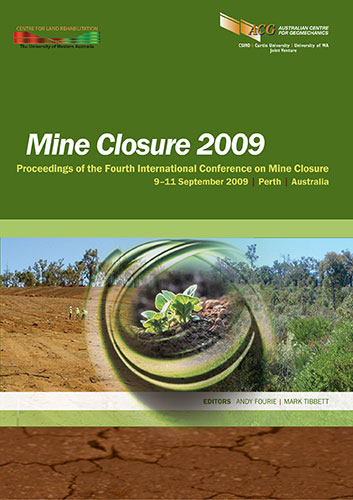Staged approach to closure of a tailings storage facility in the Kimberley, Western Australia

|
Authors: Bonstrom, KL; Chapman, D; Swain, D; O'Kane, M Paper is not available for download Contact Us |
DOI https://doi.org/10.36487/ACG_repo/908_2
Cite As:
Bonstrom, KL, Chapman, D, Swain, D & O'Kane, M 2009, 'Staged approach to closure of a tailings storage facility in the Kimberley, Western Australia', in AB Fourie & M Tibbett (eds), Mine Closure 2009: Proceedings of the Fourth International Conference on Mine Closure, Australian Centre for Geomechanics, Perth, pp. 65-77, https://doi.org/10.36487/ACG_repo/908_2
Abstract:
A nickel mine located in the Kimberley region of Western Australia is in the process of developing an amended closure plan (subject to Environmental Protection Authority (EPA) approval) for the tailings storage facility (TSF). Reference to the specific mine and location has been removed to not interfere with the approvals process. The proposed closure plan demonstrates the advantage of strategic tailings placement and long-term planning while the facility is operational in order to develop a robust final landform for post closure. In addition, the proposed plan is an example of a multidisciplinary approach to post-closure planning of a mine waste facility. Part of the proposed closure plan was to develop a moisture store–and– release cover system design and a final landform for the TSF facility. Due to the valley fill setting of the TSF, the current surface topography slopes down-gradient to a dam located at the southern most end of the TSF. In order to mitigate the possibility of a flow over from the entire valley catchment area during large rainfall events, the mine is proposing a staged closure approach where the large catchment is segmented into smaller catchments that drain to strategically located spillways. Developing separately contained internal sub-catchments increases the stability of the current TSF containment structures such that the erosional stability of the main tailings embankment is increased by decreasing runoff reporting to that region. Each segment, or cell, would be filled and closed incrementally once capacity of the cell is reached. This approach was developed in order to manage surface water runoff for large rainfall events that may occur post-closure. In order to develop the final landform for the TSF, detailed geotechnical testing of potential cover materials was completed. Soil atmosphere modelling of several potential cover scenarios and erosional stability modelling of the landform was completed to determine the most stable cover system. This closure plan was designed by coupling a moisture store–and–release cover system, which captures and stores rainfall events up to a certain magnitude, with a landform engineered to carry runoff for larger storm events off the landform with acceptable erosion rates. Cover and landform designs were approached iteratively to determine the best possible predicted net percolation to ensure success of the cover system, and most ideal sloped surface to decrease erosion during large rainfall events. Surface contouring the TFS through strategic placement of discharge spigots will aid in the development of the final landform surface. Seepage modelling of the final landform was completed to determine the post closure drain-down and seepage rates. The seepage rates and drain-down were used in regional groundwater flow and solute transport modelling to examine possible impacts on downstream receptors. The objective was to develop site-specific criteria for the cover system, in terms of required net percolation rates, which are linked to impacts to the receiving environment.
References:
Environment Australia (1998) Landform design for rehabilitation, In Best practice environmental management in
International Network for Acid Prevention (INAP) (2003) Evaluation of the long-term performance of dry cover
systems, final report, Prepared by O’Kane Consultants Inc., Report No. 684-02, March, pp. 1–31.
Mine Environment Neutral Drainage (MEND) 2.21.5 (2007) Macro-scale cover design and performance monitoring
manual, July 2007, O’Kane Consultants Inc., Report No. 702-3, July, pp. 1–108.
© Copyright 2025, Australian Centre for Geomechanics (ACG), The University of Western Australia. All rights reserved.
View copyright/legal information
Please direct any queries or error reports to repository-acg@uwa.edu.au
View copyright/legal information
Please direct any queries or error reports to repository-acg@uwa.edu.au